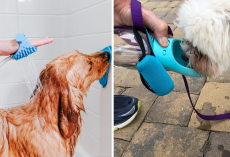Dog parents everywhere have strong opinions about the great harness vs. collar debate. Whether you’re just starting your pet-parent journey or you’ve had dogs for years, it’s completely normal to wonder which option is safest and most comfortable for your pup.
Both collars and harnesses serve the same basic purpose — they attach to a leash to keep your dog safe and by your side — but the way they work and who they’re best suited for can be very different.
Here’s a breakdown of the pros and cons of each, plus tips for choosing the right setup for your dog.
When a Collar Is the Best Choice
Collars are the traditional go-to for many dog owners. They fasten around your dog’s neck and are convenient, lightweight, and always available for ID tags. But “traditional” doesn’t automatically mean it’s the best option for every dog.
Collars work best for pups who:
- Are calm on walks
- Know basic commands
- Have good impulse control
- Don’t pull
- Communicate well with their person
Flat collars — either buckle-style or quick-release — are the most common and generally the safest everyday option. For dogs with narrow heads or wide necks, like whippets or greyhounds, a martingale collar can prevent slipping out while still being gentle when used correctly.
Try this quick release collar from Amazon
Or this buckle collar from Amazon
If your dog would benefit from a martingale collar, try this one from Amazon
Downsides of Collars
Collars aren’t ideal for every dog. If your pup pulls, lunges, or hasn’t mastered leash manners yet, a collar can make walks uncomfortable for both of you — and potentially cause neck strain.
Another downside: Collars can be misused as a way to reprimand their dog in a way that could be harmful. A martingale should never be tightened or used like a choke collar. They’re designed for security, not punishment, and should only be used with positive reinforcement training.
When a Harness Is the Better Fit
Harnesses are often a safer, more comfortable choice for many dogs. Instead of putting pressure on the neck, they wrap around the chest and torso, giving you more control without risking injury.
Harnesses are especially helpful for:
- Strong dogs who pull
- Small dogs who might slip out of a collar
- Dogs still learning basic leash skills
- Pups who need more stability or support
Because a harness distributes pressure across the chest instead of the throat, many dogs find them more comfortable — and you may find walks easier to manage.
Downsides of Harnesses
Not all harnesses are created equal. Many traditional styles clip on the dog’s back, which can actually encourage pulling since it gives the dog more leverage.
A back-clip harness can also make jumping or lunging easier if you’re using a short leash.
If that’s a concern, switching to a front-clip or no-pull harness can give you much better control and reduce pulling right away.
Try this no-pull harness from Amazon
So… Harness or Collar?
Both tools have their strengths, and the “best” option can vary depending on your dog’s size, training level, and personality.
That said, most trainers agree there’s a clear winner for everyday walking:
A front-clip harness is the safest, most effective choice for most dogs.
Puppies — and even many adult dogs — aren’t born knowing how to heel or control their impulses. Since it takes time and training to build good leash manners, a front-clip harness gives you the control you need without putting pressure on your dog’s neck.
Collars still have an important role for holding ID tags and for calm, fully trained dogs — but for most pups, especially beginners, a harness makes walks more pleasant and more secure.
We independently pick all the products we recommend because we love them and think you will too. If you buy a product from a link on our site, we may earn a commission.











